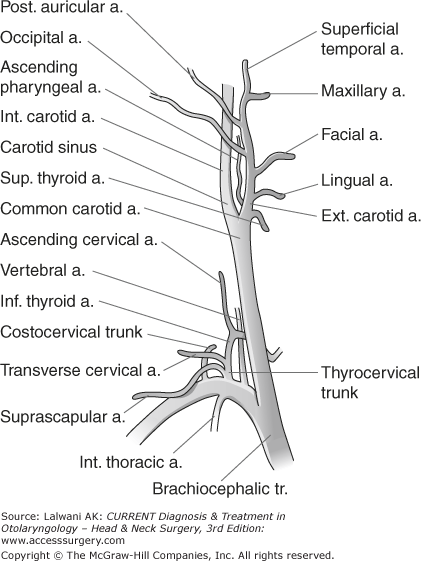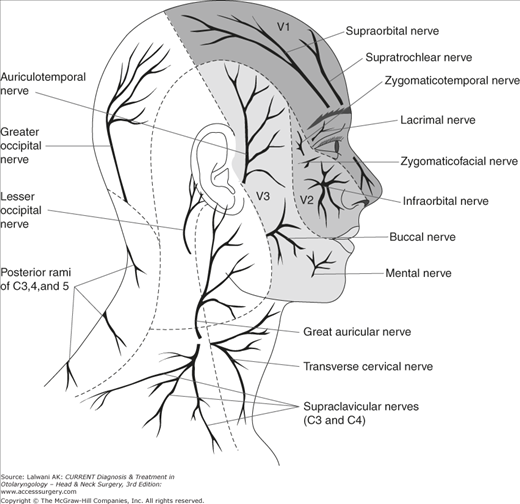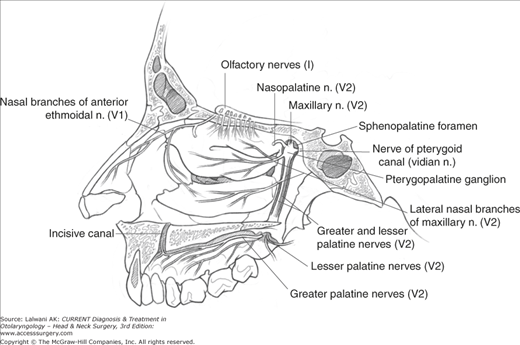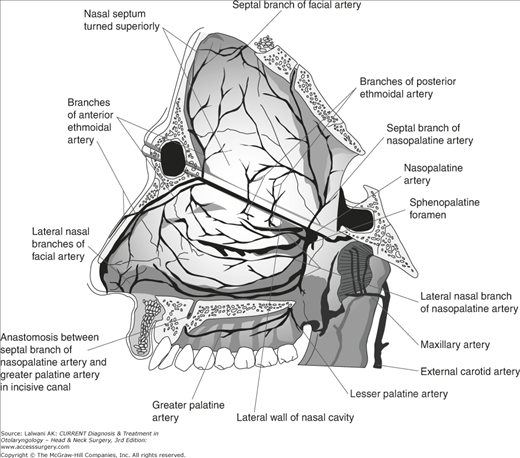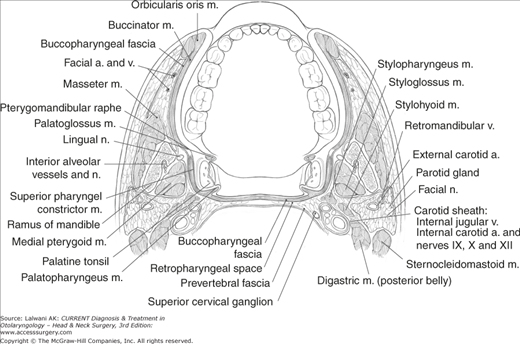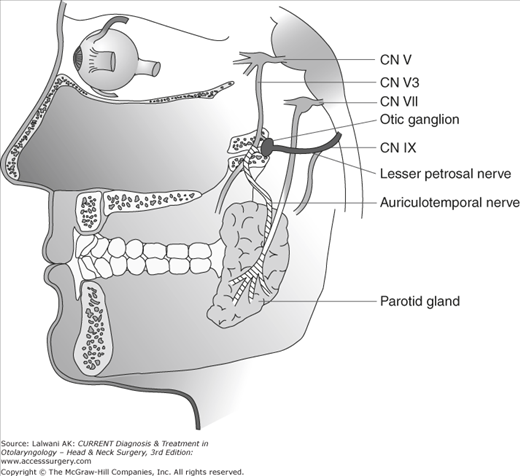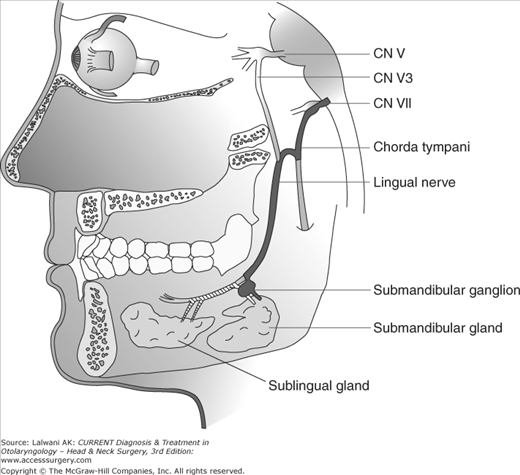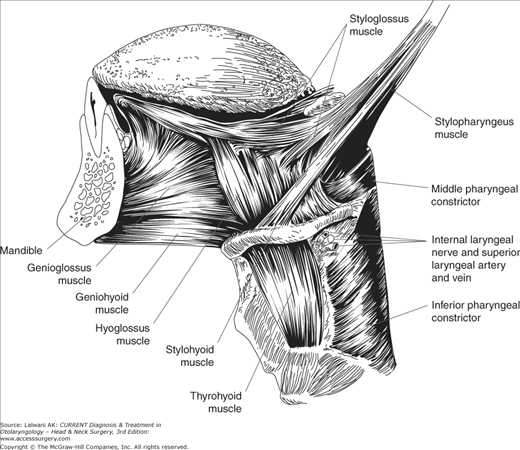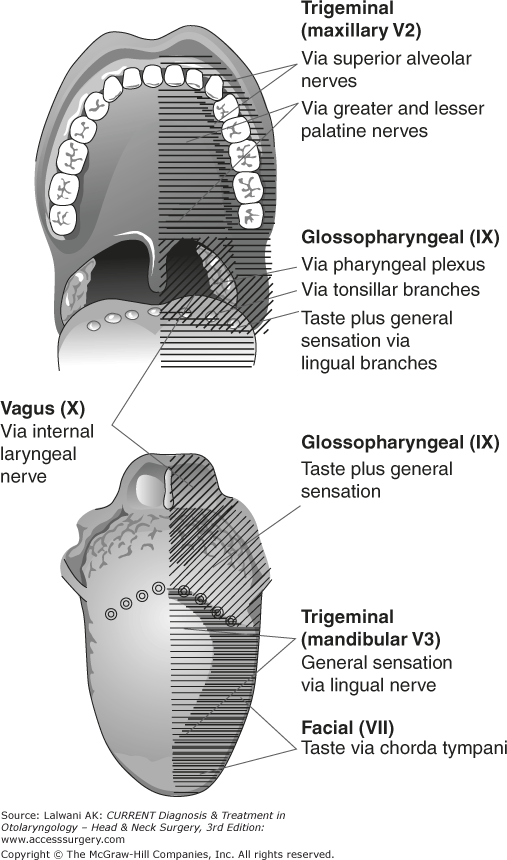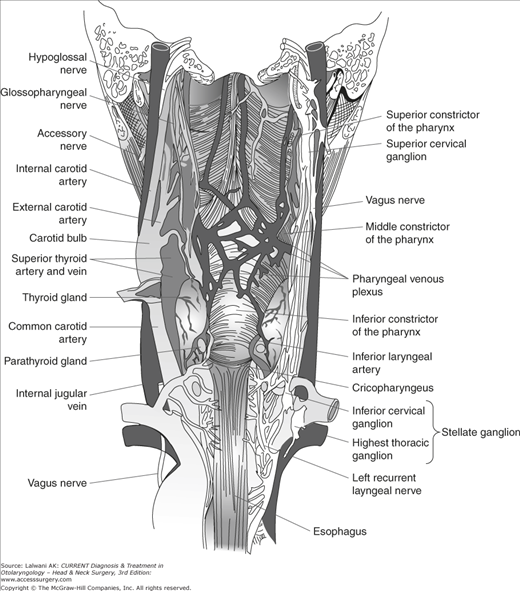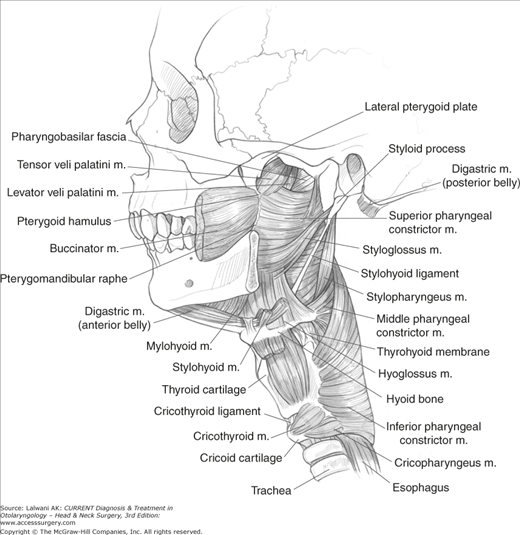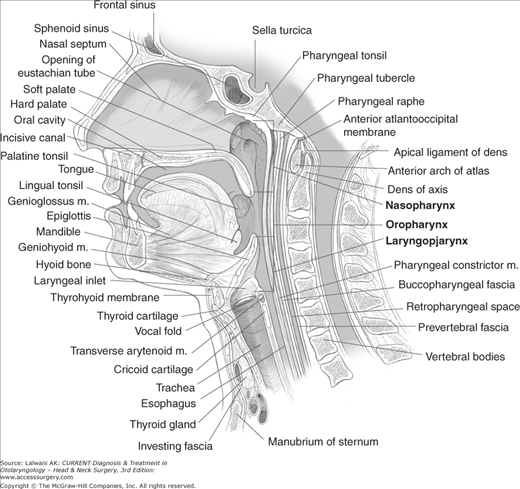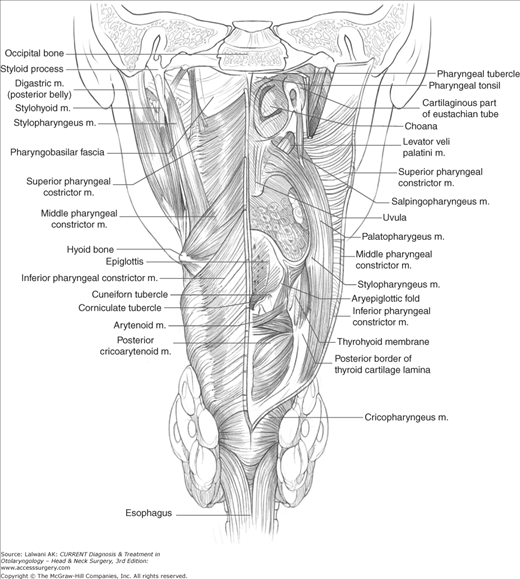Anatomy: Introduction
The anatomy of the head and neck is rich in complexity as it is populated with motor and sensory organs, cranial nerves, major arterial and venous structures in a compact three dimensional space. This chapter provides a broad and concise overview to familiarize the novice and yet detailed enough to serve as a reference for the more knowledgeable clinician.
Face
The muscles of facial expression develop from the second branchial arch and lie within the skin of the scalp, face, and neck (Figure 1–1).
The occipitofrontalis muscle, which lies in the scalp, extends from the superior nuchal line in the back to the skin of the eyebrows in the front. It allows for the movement of the scalp against the periosteum of the skull and also serves to raise the eyebrows.
The orbicularis oculi muscle lies in the eyelids and also encircles the eyes. It helps to close the eye in the gentle movements of blinking or in more forceful movements, such as squinting. These movements help express tears and move them across the conjunctival sac to keep the cornea moist.
The orbicularis oris muscle encircles the opening of the mouth and helps to bring the lips together to keep the mouth closed.
The buccinator muscle arises from the pterygomandibular raphe in the back and courses forward in the cheek to blend into the orbicularis oris muscle in the lips. It helps to compress the cheek against the teeth and thus empties food from the vestibule of the mouth during chewing. In addition, it is used while playing musical instruments and performing other actions that require the controlled expression of air from the mouth.
The platysma muscle extends from the skin over the mandible through the superficial fascia of the neck into the skin of the upper chest, helping to tighten this skin and also to depress the angles of the mouth. Although lying primarily in the neck, it is grouped with the muscles of facial expression.
The blood supply of the face is through branches of the facial artery (Figure 1–2). After arising from the external carotid artery in the neck, the facial artery passes deep to the submandibular gland and crosses the mandible in front of the attachment of the masseter muscle. It takes a tortuous course across the face and travels up to the medial angle of the eye, where it anastomoses with branches of the ophthalmic artery. It gives labial branches to the lips, of which the superior labial artery enters the nostril to supply the vestibule of the nose.
The occipital, posterior auricular, and superficial temporal arteries supply blood to the scalp. They all arise from the external carotid artery. The superficial temporal artery gives a branch, the transverse facial artery, which courses through the face parallel to the parotid duct.
The superficial temporal and maxillary veins join within the substance of the parotid gland to form the retromandibular vein (Figure 1–3). The facial vein joins the anterior division of the retromandibular vein to drain into the internal jugular vein. Additional details about the venous drainage pattern of the scalp and face are provided in the discussion of the veins of the neck. The facial vein communicates with both the pterygoid venous plexus and the veins in the orbit. Each of these has connections to the cavernous sinus, thus allowing infections to spread from the face into the cranium.
The sensory innervation of the face is through terminal branches of the trigeminal nerve (V) (Figure 1–4). Two imaginary lines that split the eyelids and the lips help to approximately demarcate the sensory distribution of the three divisions of the trigeminal nerve.
In addition to the skin of the face, branches of the trigeminal nerve (V) are also responsible for carrying sensation from deeper structures of the head, including the eye, the paranasal sinuses, the nose, and the mouth. The details of this distribution are discussed with the orbit and the pterygopalatine and infratemporal fossae.
The ophthalmic division of the trigeminal nerve (V1) carries sensation from the upper eyelid, the skin of the forehead, and the skin of the nose. Its cutaneous branches, from lateral to medial, are the lacrimal, supraorbital, supratrochlear, and nasal nerves.
The maxillary division of the trigeminal nerve (V2) carries sensation from the lower eyelid, the upper lip, and the face up to the zygomatic prominence of the cheek. Its cutaneous branches are the infraorbital, zygomaticofacial, and zygomaticotemporal nerves.
The mandibular division of the trigeminal nerve (V3) carries sensation from the lower lip, the lower part of the face, the auricle, and the scalp in front of and above the auricle. Its cutaneous branches are the mental, buccal, and auriculotemporal nerves.
The muscles of facial expression are innervated by branches of the facial nerve (VII). After emerging from the stylomastoid foramen, the facial nerve lies within the substance of the parotid gland. Here, it gives off its five terminal branches: (1) The temporal branch courses up to the scalp to innervate the occipitofrontalis and orbicularis oculi muscles. (2) The zygomatic branch courses across the cheek to innervate the orbicularis oculi muscle. (3) The buccal branch travels with the parotid duct and innervates the buccinator and orbicularis oris muscles, and also muscles that act on the nose and upper lip. (4) The mandibular branch innervates the orbicularis oris muscle and other muscles that act on the lower lip. (5) The cervical branch courses down to the neck and innervates the platysma muscle.
Nose & Sinuses
The nose is bounded from above by the cribriform plate of the ethmoid bone and from below by the hard palate. It extends back to the choanae, which allow it to communicate with the nasopharynx. The nasal septum is formed by the perpendicular plate of the ethmoid and the vomer bones. The lateral wall of the nose has three bony projections, the conchae, which increase the surface area of the nasal mucosa and help to create turbulence in the air flowing through the nose. This allows the nose to humidify and clean the inhaled air and also to change the air to body temperature. The spaces between the conchae and the lateral wall of the nose are called the meatuses. The middle meatus typically has a bulge in its lateral nasal wall, the bulla ethmoidalis, which is created by the presence of ethmoidal air cells. This bulge is bounded from below by a groove, the hiatus semilunaris. The mucous membrane of the nasal cavity is primarily ciliated columnar epithelium and is specialized for olfaction in the roof of the nose and on the upper surface of the superior concha.
Several bones that surround the nose are hollow, and the spaces contained within, the paranasal sinuses, are named for the skull bones in which they lie. They are lined by a mucous membrane that is continuous with the nasal mucosa through openings with which the paranasal sinuses communicate with the nose. The presence of the sinuses decreases the weight of the skull and provides resonant chambers for voice. The secretions of the sinuses are carried into the nose through ciliary action.
The frontal sinus drains into the anterior part of the hiatus semilunaris via the infundibulum. The maxillary sinus also drains into the hiatus semilunaris, as do the anterior and middle ethmoidal sinuses. The posterior ethmoidal sinuses drain into the superior meatus. The sphenoid sinus drains into the space above the superior concha called the sphenoethmoidal recess. The inferior end of the nasolacrimal duct opens in the inferior meatus, allowing tears from the conjunctival sac to be carried into the nose. The maxillary sinus lies between the orbit above and the mouth below. The roots of the upper premolar and molar teeth project into the maxillary sinus, often separated from the contents of the sinus only by the mucous membrane that lines the sinus cavity.
The olfactory nerves (I) pass through the cribriform plate of the ethmoid bone into the olfactory bulb lying in the anterior cranial fossa, carrying the sensations of smell from the olfactory mucosa in the roof of the nose (Figure 1–5). General sensory fibers to the nose are provided by the ophthalmic (V1) and maxillary (V2) divisions of the trigeminal nerve. Specifically, the sensory innervation of the mucosa lining the anterior part of the nasal cavity, as well as that surrounding the olfactory mucosa in the roof of the nose, is by the ethmoidal branches of the ophthalmic division of the trigeminal nerve. Sensation from the lateral wall of the nose is carried by the lateral nasal branches of the maxillary division of the trigeminal nerve. Sensation from the nasal septum is carried by the nasopalatine branch of the maxillary division of the trigeminal nerve.
The sensory innervation of the lining of the frontal sinus is by the supraorbital branch of the ophthalmic division of the trigeminal nerve (V1). Sensory innervation of the sphenoid and ethmoid sinuses is by the ethmoidal branches of the ophthalmic division of the trigeminal nerve. Sensory innervation of the maxillary sinus is by the infraorbital branch of the maxillary division of the trigeminal nerve (V2).
The rich blood supply of the nasal cavity is primarily from the sphenopalatine branch of the maxillary artery that enters the nose from the pterygopalatine fossa (Figure 1–6). The superior labial branch of the facial artery supplies the vestibule of the nose. In addition, the ophthalmic branch of the internal carotid artery supplies the roof of the nose. All of these vessels anastomose with each other.
Salivary Glands
The parotid gland is wedged into the space between the mandible in front and the temporal bone above and behind. It lies in front of the external auditory meatus. It extends as deep as the pharyngeal wall and is enclosed within a sheath formed by the investing fascia of the neck, which is attached to the zygomatic arch above. The parotid duct passes forward over the masseter muscle and can be palpated just in front of the clenched muscle, about half an inch below the zygomatic arch. It passes into the oral cavity by piercing the buccinator muscle and opens in the buccal mucosa opposite the upper second molar tooth.
Several important structures lie within the capsule of the parotid gland (Figure 1–7). The facial nerve (VII) enters the gland after emerging from the stylomastoid foramen and gives off its terminal branches within the substance of the gland. The external carotid artery ascends up the neck, into the gland, and gives off its two terminal branches—the maxillary and superficial temporal arteries—within the gland. The superficial temporal and maxillary veins come together in the substance of the gland to form the retromandibular vein, which divides into its anterior and posterior divisions as it emerges from the gland.
The submandibular gland lies in the digastric triangle of the neck, below the mylohyoid muscle. Like the parotid gland, it is enclosed within a sheath formed by the investing fascia of the neck that is attached to the mandible above. A part of the gland extends around the posterior, free edge of the mylohyoid muscle to lie above the muscle in the floor of the mouth. The submandibular duct arises from this deep portion of the gland and extends forward, alongside the tongue, to open at the base of the frenulum of the tongue on the submandibular caruncle.
The sublingual gland lies below the tongue in the floor of the mouth. It creates a fold of mucous membrane, the sublingual fold, which lies along the base of the tongue, above the mylohyoid muscle. The gland has multiple ducts that open along the sublingual fold.
Although the facial nerve (VII) is responsible for almost all the parasympathetic secretomotor innervation of the head, it is interesting to note that the one gland to which it does not provide secretomotor innervation is the very gland in which it is buried. The secretomotor innervation of the parotid gland is by fibers carried on the glossopharyngeal nerve (IX). The preganglionic parasympathetic fibers originate in the inferior salivary nucleus and join the glossopharyngeal nerve (Figure 1–8). They course through the lesser superficial petrosal nerve and the foramen ovale to synapse at the otic ganglion. The postganglionic fibers now join the auriculotemporal branch of the mandibular division of the trigeminal nerve to reach the parotid gland.
Figure 1–8.
Schematic of the innervation of the parotid gland by the glossopharyngeal nerve (IX). Solid black: Preganglionic parasympathetic nerves leave the brainstem with the glossopharyngeal nerve and run via the lesser superficial petrosal nerve to the otic ganglion. Hatched segment: Postganglionic parasympathetic nerves travel with the auriculotemporal branch of the mandibular division of the trigeminal nerve (V3) and then the facial nerve (VII) to reach the parotid gland.
The secretomotor innervation of the submandibular and sublingual glands is by fibers carried on the facial nerve (VII). The preganglionic parasympathetic fibers originate in the superior salivary nucleus and join the facial nerve (Figure 1–9). They course through the chorda tympani nerve and the petrotympanic fissure to join the lingual branch of the mandibular division of the trigeminal nerve (V3) in the infratemporal fossa, and they synapse at the submandibular ganglion. Postganglionic fibers coursing to the submandibular gland usually reach the gland directly from this ganglion. Postganglionic fibers coursing to the sublingual gland reach the gland on branches of the lingual nerve.
Figure 1–9.
Schematic of the innervation of the submandibular and sublingual glands by the facial nerve (VII). Solid black: Preganglionic parasympathetic nerves leave the brainstem with the facial nerve and run via the chorda tympani and the lingual branches of the mandibular division of the trigeminal nerve (V3) to the submandibular ganglion. Hatched segment: Postganglionic parasympathetic nerves travel either directly to the submandibular gland or travel back to the lingual nerve to the sublingual gland.
The sympathetic innervation to the salivary glands controls the viscosity of the glandular secretions. The preganglionic neurons originate in the thoracic spinal cord and ascend in the sympathetic trunk to synapse in the superior cervical ganglion in the neck. From here, postganglionic sympathetic fibers travel as plexuses on the external carotid artery and its branches to reach the salivary glands.
Oral Cavity
The mouth is bounded by the palate above, the mylohyoid muscle below, the buccinator muscles in the cheek on each side, and the palatoglossal arches behind. In addition to the oral cavity proper, the mouth includes the vestibule, which is the space between the cheek and the teeth.
The hard palate is formed by the palatal process of the maxilla and the horizontal process of the palatine bone, which are covered by a mucous membrane. The soft palate is formed by contributions from a number of muscles.
The tensor veli palatini arises from the scaphoid fossa of the sphenoid bone and descends in the lateral wall of the nose, narrowing to a tendon that turns medially around the pterygoid hamulus. It then fans out to become the palatine aponeurosis and attaches to the muscle of the opposite side. Together, the two muscles tense the soft palate for other muscles to act upon it.
The levator veli palatini arises from the petrous part of the temporal bone near the base of the styloid process and from the cartilage of the eustachian tube. It passes between the lowest fibers of the superior pharyngeal constrictor muscle and the highest fibers of the middle pharyngeal constrictor muscle, attaching to the upper surface of the palatine aponeurosis. It helps to elevate the soft palate and, together with the palatopharyngeus and superior pharyngeal constrictor muscles, it closes off the nose from the oropharynx during swallowing.
The palatoglossus muscle arises from the lower surface of the palatine aponeurosis and passes down, in front of the palatine tonsil, to attach to the side of the tongue. It pulls the back of the tongue upward and approximates the soft palate to the tongue, closing off the mouth from the pharynx.
The palatopharyngeus muscle also arises from the lower surface of the palatine aponeurosis and passes down, behind the palatine tonsil, to blend into the longitudinal muscle layer of the pharynx. It helps to pull the pharyngeal wall upward during swallowing, and together with the levator veli palatini and superior pharyngeal constrictor muscles, it closes off the nose from the oropharynx.
The musculus uvulae is a small muscle that helps to elevate the uvula.
The blood supply of the palate is from the ascending palatine branches of the facial artery as well as from the palatine branch of the maxillary artery, both of which drop down to the palate from the pterygopalatine fossa by passing through the palatine canal.
The anterior two-thirds of the tongue develop separately from the posterior third, and the two parts come together at the sulcus terminalis. The surface of the anterior two-thirds of the tongue is covered by filiform, fungiform, and vallate papillae. The posterior third of the tongue contains collections of lymphoid tissue, the lingual tonsils.
The mass of the tongue is made up of intrinsic muscles that are directed longitudinally, vertically, and transversely; these intrinsic muscles help to change the shape of the tongue. Several extrinsic muscles help to move the tongue (Figure 1–10).
The genioglossus arises from the genial tubercle on the inside surface of the front of the mandible and passes upward and backward into the tongue. It acts to protrude and depress the tongue.
The hyoglossus arises from the hyoid bone and passes upward to attach to the side of the posterior part of the tongue. It acts to depress and retract the back of the tongue.
The styloglossus arises from the styloid process and passes downward and forward through the middle pharyngeal constrictor muscle to attach to the side of the tongue. It acts to elevate and retract the tongue.
The palatoglossus muscle (described previously) acts on the tongue but is considered a muscle of the palate.
The blood supply of the tongue is from the lingual branch of the external carotid artery. The lingual artery reaches the tongue by passing behind the posterior edge of the hyoglossus muscle and turning forward into the substance of the tongue, thus coursing medial to the hyoglossus. In contrast, all the other nerves and vessels of the tongue pass forward lateral to the hyoglossus before entering the tongue.
The floor of the mouth is formed by the mylohyoid muscle upon which lie the geniohyoid muscles (Figure 1–11). The digastric muscle lies immediately below the mylohyoid muscle. Both the geniohyoid and the digastric muscles are discussed with the suprahyoid muscles of the neck. The mylohyoid arises from the similarly named line on the inside surface of the mandible and attaches to the front of the hyoid bone. It is the main support of the structures in the mouth. It helps to elevate the hyoid bone during movements of swallowing and speech. Also, with the infrahyoid muscles holding the hyoid bone in place, the mylohyoid and digastric muscles help to depress the mandible and open the mouth.
The deep part of the submandibular gland and the duct that emerges from it lie above the mylohyoid muscle. The sublingual gland also lies above the mylohyoid. The hypoglossal nerve (XII) enters the mouth from the neck by passing lateral to the hyoglossus muscle and above the free posterior edge of the mylohyoid muscle. It continues in the mouth, inferior to the submandibular duct, and enters the substance of the tongue at its side. The lingual branch of the mandibular division of the trigeminal nerve (V3) enters the mouth from the infratemporal fossa by passing medial to the lower third molar. It initially lies above and lateral to the submandibular duct and then spirals under the duct as it comes to lie above and medial to the duct, where it gives off its terminal branches to the tongue and the floor of the mouth. The glossopharyngeal nerve (IX) passes from the pharynx to the mouth, lies lateral to the bed of the palatine tonsil, and courses into the posterior third of the tongue.
Sensation from the palate is carried by branches of the maxillary division of the trigeminal nerve (Figure 1–12). From the front of the hard palate, just behind the incisors, sensation is carried by the incisive branch of the nasopalatine nerve. From the rest of the hard palate and the mucosa lining the palatal aspect of the upper alveolar margins, sensation is carried by the greater palatine nerve. From the soft palate, sensation is carried by the lesser palatine nerve.
Sensation from the tongue is carried by nerves predicated upon the development of the tongue. There are general sensory fibers that carry sensations of touch, pressure, and temperature. In addition, there are special sensory fibers that carry the sensation of taste.
General sensation from the anterior two-thirds of the tongue is carried by the lingual branch of the mandibular division of the trigeminal nerve (V3). General sensation from the posterior third of the tongue is carried by the glossopharyngeal nerve (IX). Taste sensation from the anterior two-thirds of the tongue is carried by the chorda tympani branch of the facial nerve (VII). Taste sensation from the posterior third of the tongue is carried by the glossopharyngeal nerve (IX).
Sensation from the floor of the mouth and the mucosa lining the lingual aspect of the lower alveolar margins is carried by the lingual branch of the mandibular division of the trigeminal nerve (V3). Sensation from the buccal mucosa and the mucosa lining the buccal aspect of the upper and lower alveolar margins is carried by the buccal branch of the mandibular division of the trigeminal nerve (V3). Sensation from the mucosa lining the anterior part of the vestibule, inside the upper lip, and the adjacent mucosa lining the labial aspect of the upper alveolar margins is carried by the infraorbital branch of the maxillary division of the trigeminal nerve (V2). Sensation from the mucosa lining the anterior part of the vestibule, inside the lower lip, and the adjacent mucosa lining the labial aspect of the lower alveolar margins is carried by the mental branch of the inferior alveolar branch of the mandibular division of the trigeminal nerve (V3).
All the muscles of the palate are innervated by branches of the vagus nerve (X) except the tensor veli palatini, which is innervated by the mandibular division of the trigeminal nerve (V3). All the muscles of the tongue, extrinsic and intrinsic, are innervated by the hypoglossal nerve (XII) except the palatoglossus muscle, which is considered a muscle of the palate and is therefore innervated by the vagus nerve (X). The mylohyoid muscle and anterior belly of the digastric muscle are innervated by the nerve to the mylohyoid muscle, a branch of the mandibular division of the trigeminal nerve (V3). The posterior belly of the digastric and the stylohyoid muscle are innervated by the facial nerve (VII). The geniohyoid muscle is innervated by fibers from the cervical spinal cord (C1), which are carried to it by the hypoglossal nerve (XII).
Pharynx
The pharynx is a muscular tube that both lies behind and communicates with the nasal, oral, and laryngeal cavities (Figure 1–13). It lies in front of the prevertebral fascia of the neck and is continuous with the esophagus at the level of the cricoid cartilage. From within, it is made of mucosa, pharyngobasilar fascia, pharyngeal muscles, and buccopharyngeal fascia.
The mucosa is lined by ciliated columnar epithelium in the area behind the nasal cavity and by stratified squamous epithelium in the remaining areas. The pharyngobasilar fascia, a fibrous layer, is attached above to the pharyngeal tubercle on the base of the skull. The muscles of the pharynx consist of the circular fibers of the constrictor muscles that surround the longitudinally running fibers of the stylopharyngeus, salpingopharyngeus, and palatopharyngeus muscles.
The buccopharyngeal fascia is a layer of loose connective tissue that separates the pharynx from the prevertebral fascia and allows for the free movement of the pharynx against vertebral structures. This layer is continuous around the lower border of the mandible with the loose connective tissue layer that separates the buccinator muscle from the skin overlying it.
The muscular layer of the pharynx is made of inner longitudinal and outer circular layers (Figure 1–14). The longitudinally running muscles help to shorten the height of the pharynx. As the pharyngobasilar fascia is attached to the skull, this shortening results in an elevation of the pharynx and larynx during swallowing. The salpingopharyngeus, stylopharyngeus, and palatopharyngeus muscles contribute to this layer.
The circularly running muscles help to constrict the pharynx, and their sequential contractions propel food downward into the esophagus. The superior pharyngeal constrictor muscle arises from the pterygomandibular raphe, the middle pharyngeal constrictor muscle from the hyoid bone, and the inferior pharyngeal constrictor muscle from the thyroid and cricoid cartilages. From these narrow anterior origins, the fibers of the constrictor muscles fan out as they travel back around the pharynx and attach to the corresponding muscles of the opposite side at the midline pharyngeal raphe. The pharyngeal raphe is attached along its length to the pharyngobasilar fascia and is thus anchored to the pharyngeal tubercle on the base of the skull. The orientation of the constrictor muscle fibers is such that the inferior fibers of one muscle are overlapped on the outside by the superior fibers of the next muscle down, producing a “funnel-inside-a-funnel” arrangement that directs food down in an appropriate fashion.
The narrow anterior attachments of the constrictor muscles, compared with their broad posterior insertion, create gaps in the circular muscle coat that surrounds the pharynx. Structures from without can pass into the pharynx through these gaps.
The gap between the base of the skull and the upper fibers of the superior inferior constrictor muscle allows the eustachian tube and the levator veli palatini muscle into the nasopharynx.
The gap between the lower fibers of the superior pharyngeal constrictor muscle and the upper fibers of the middle pharyngeal constrictor muscle allows the stylopharyngeus muscle and the glossopharyngeal nerve (IX) into the oropharynx.
The gap between the lower fibers of the middle pharyngeal constrictor muscle and the upper fibers of the inferior pharyngeal constrictor muscle allows both the internal laryngeal branch of the vagus nerve (X) and the superior laryngeal branch of the superior thyroid artery into the laryngopharynx and the larynx.
The gap between the lower fibers of the inferior pharyngeal constrictor muscle and the upper fibers of the circular muscle of the esophagus allows both the recurrent laryngeal branch of the vagus nerve (X) and the inferior laryngeal branch of the inferior thyroid artery into the larynx.
The innervation of the pharynx is by a group of nerves whose branches form a meshwork of neurons, the pharyngeal plexus, which lies in the wall of the pharynx. The glossopharyngeal nerve (IX), the vagus nerve (X), the maxillary division of the trigeminal nerve (V2), and postganglionic fibers from the sympathetic trunk all contribute to the formation of the pharyngeal plexus.
The sensory innervation of the upper part of the nasopharynx is carried by branches of the maxillary division of the trigeminal nerve (V2). The sensory innervation of the lower part of the nasopharynx, the oropharynx, and the laryngopharynx is carried by the glossopharyngeal nerve (IX). The internal laryngeal branch of the vagus nerve (X) carries sensation from the piriform recesses of the laryngopharynx.
Motor innervation of all the muscles of the pharynx, circular and longitudinal, except the stylopharyngeus, is by the pharyngeal branch of the vagus nerve (X), which carries motor fibers that originated in the cranial component of the accessory nerve (XI). The stylopharyngeus muscle is innervated by the glossopharyngeal nerve (IX).
The nasopharynx extends from the base of the skull to the level of the soft palate (Figures 1–15 and 1–16). It is continuous with the nasal cavity through the choanae. In its lateral wall, the cartilage of the eustachian tube creates a bulge, the torus tubarius, below which is the opening of the tube. Above and behind this bulge lies a depression called the pharyngeal recess. A collection of lymphoid tissue, the pharyngeal tonsil, lies in the posterior wall and the roof of the nasopharynx. Additional lymphoid tissue, the tubal tonsil, is found around the opening of the eustachian tube. A fold of mucous membrane created by the salpingopharyngeus muscle extends down from the torus tubarius. The nasopharynx is continuous with the oropharynx below.
The oropharynx extends from the soft palate to the epiglottis (Figures 1–15 and 1–16). It is continuous with the mouth through the oropharyngeal isthmus formed by the palatoglossal muscles on each side. The anterior wall of the oropharynx is formed by the posterior third of the tongue. The mucous membrane of the tongue is continuous onto the epiglottis and creates three glossoepiglottic folds—one in the midline and two placed laterally. The space on either side of the median glossoepiglottic fold is the vallecula.
The lateral wall of the oropharynx has two folds of mucous membrane, the palatoglossal and palatopharyngeal, created by the muscles of the same name, which are described with the muscles of the palate. An encapsulated collection of lymphoid tissue, the palatine tonsil, lies in the triangular recess between these two folds. The blood supply of the palatine tonsil is by a branch of the facial artery. Additional lymphoid tissue, the lingual tonsil, is located under the mucous membrane of the posterior third of the tongue. Together, the tonsillar tissues of the nasopharynx and oropharynx form a ring of lymphoid tissue—Waldeyer’s ring—that surrounds the entrances into the pharynx from the nose and the mouth. The oropharynx is continuous with the laryngopharynx below.
The laryngopharynx extends from the epiglottis to the cricoid cartilage (Figures 1–15 and 1–16). It is continuous with the larynx through the laryngeal aditus, which is formed by the epiglottis and the aryepiglottic folds. On either side of these folds and medial to the thyroid cartilage are two pyramidal spaces, the piriform recesses of the laryngopharynx, through which swallowed food passes into the esophagus. The piriform recesses are related to the cricothyroid muscle laterally and the lateral cricoarytenoid muscle medially. The laryngopharynx is continuous with the esophagus below.

